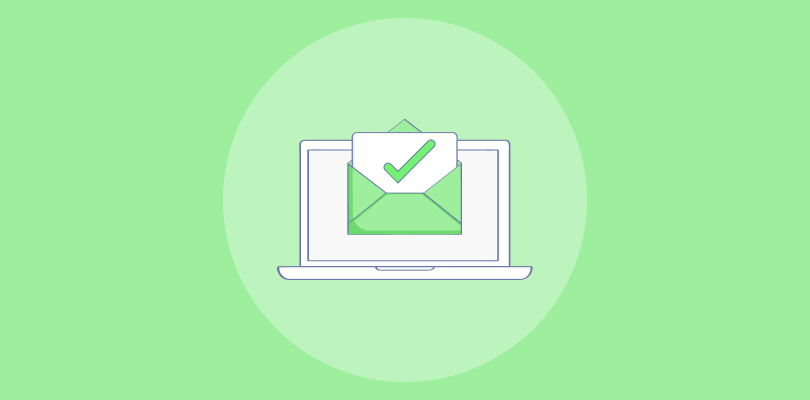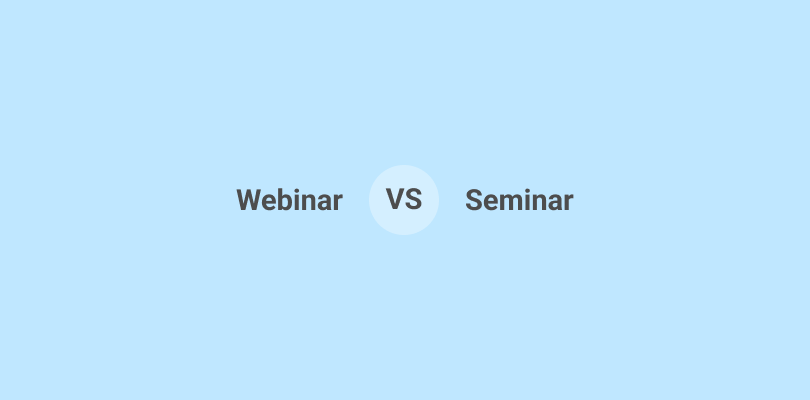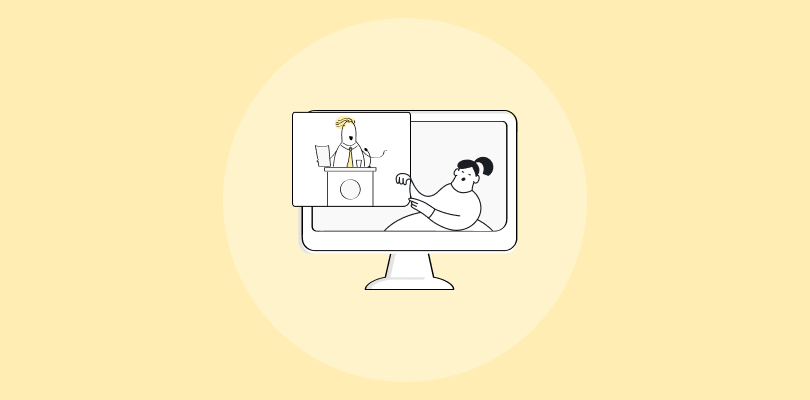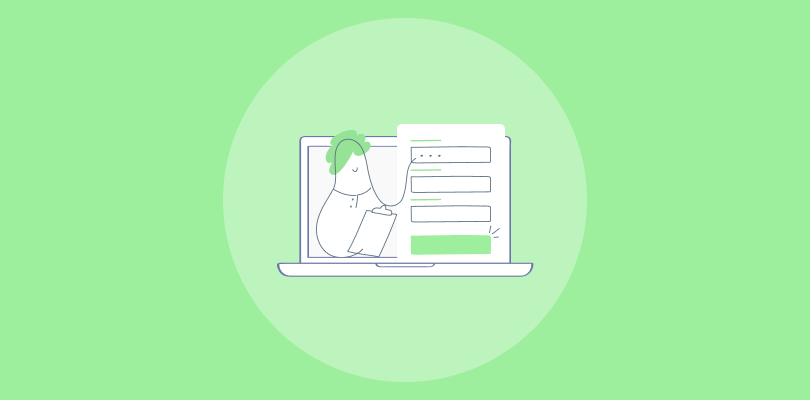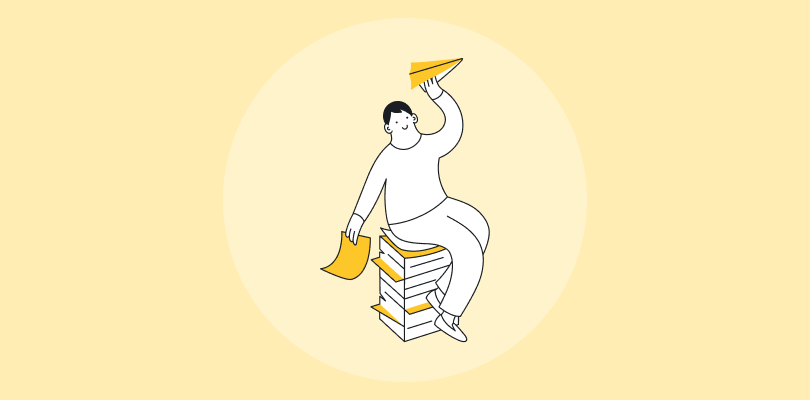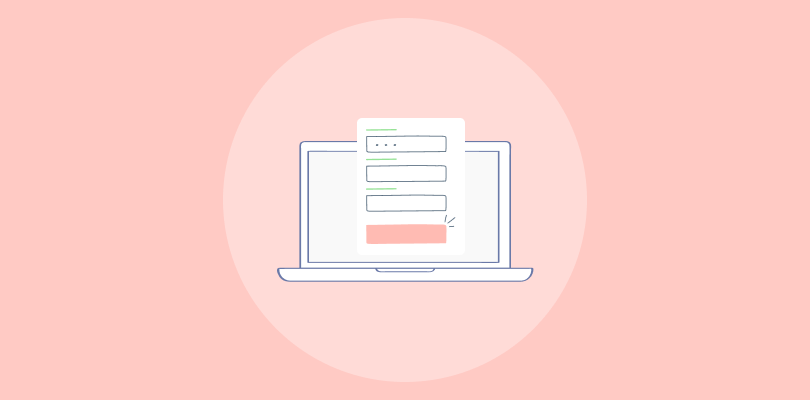Do you know what works magically well to get webinar attendees?
It’s the webinar email sequences that remind the registrants at the right moment so they do not miss out on something valuable.
As a part of the webinar industry for nearly a decade, I have realized that email marketing can be pure gold in attracting the right audience, thereby increasing attendance and conversions.
But what do you send in webinar emails? And what’s the correct time to send these emails?
Here’s a detailed guide with answers to all your questions about an email sequence for webinars.
Let’s dig in.
Why Use a Webinar Email Sequence
A webinar email sequence is one of the most effective tools for maximizing attendance, keeping registrants engaged, and reinforcing key takeaways after the event.
Here’s why you should consider implementing one:
- Drive Registrations and Remind Attendees
An email sequence nudges potential attendees to register early and ensures they stay informed and excited about the webinar. By sending reminder emails leading up to the event, you can significantly reduce no-show rates and ensure more people tune in.
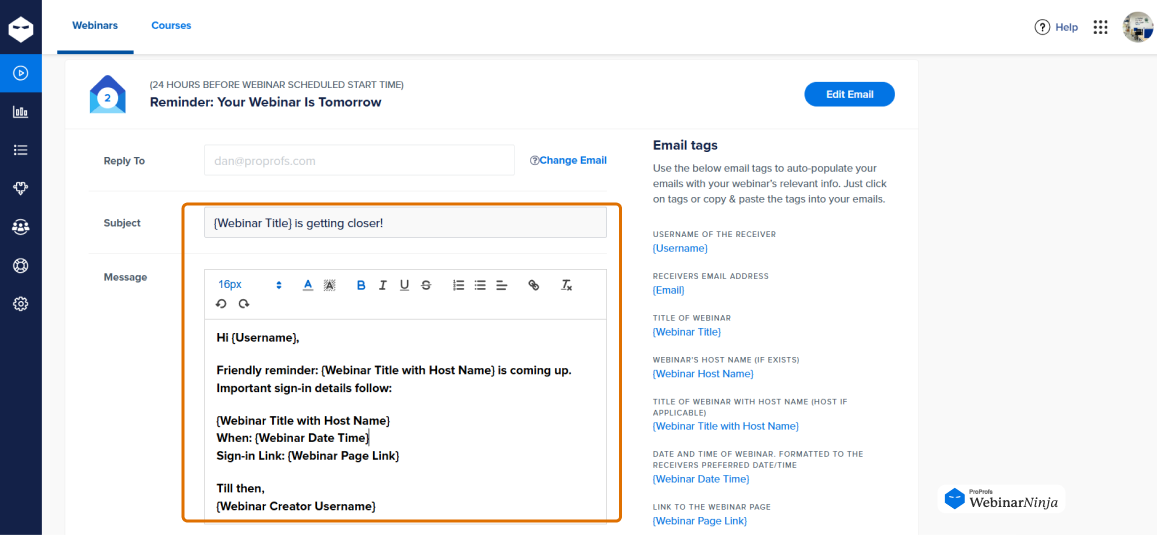
- Enhance Audience Engagement
Pre-webinar emails can introduce key topics, speakers, and benefits, creating anticipation. During the webinar, you can send live updates or interactive polls, and post-webinar emails allow attendees to stay engaged by reviewing highlights or accessing exclusive content like Q&A summaries or bonus materials.
- Strengthen Your Brand’s Authority:
A well-crafted email sequence positions you as a thought leader, showcasing your commitment to providing valuable information. This builds trust, reinforcing your authority in the field and encouraging attendees to seek out future webinars or content.
- Boost Conversions:
If the webinar is part of a product launch or service offering, follow-up emails with compelling CTAs can help convert attendees into customers. You can leverage post-webinar emails to share case studies, testimonials, and special offers, which can drive conversions effectively.
- Gather Valuable Feedback:
After the webinar, an email with a survey link can gather insights on what attendees liked, disliked, or wanted more of. This feedback is essential for refining future webinars and ensuring your content meets audience expectations.
Key Components of a Webinar Email Sequence
A well-structured email sequence for webinars has multiple components to engage, inform, and convert attendees.
Let’s break down each component by email type and also check out examples of each:
1. Invitation Email Sequence
This sequence is designed to capture interest and increase webinar registrations.
Components:
Subject Line: Grab attention immediately.
- Example: “Don’t Miss Out! [Webinar Topic] – Reserve Your Spot Now!”
Personalized Greeting: Address the recipient by name if possible.
- Example: “Hi [Name],”
Event Introduction: Clearly explain what the webinar is about.
- Example: “Join us for an in-depth look at [Topic], where we’ll uncover [Main Benefits].”
Value Proposition: Emphasize the benefits and key takeaways.
- Example: “In just 45 minutes, you’ll learn how to [Key Benefit #1, Key Benefit #2, Key Benefit #3].”
Speaker Introduction: Briefly introduce the presenter(s) to build credibility.
- Example: “[Speaker Name] is an expert in [Industry/Field] with [# years] of experience.”
Call-to-Action (CTA): Encourage immediate registration with a bold button.
- Example: “Secure Your Spot Now!”
Date and Time: Make the event time clear and show timezone options.
- Example: “Mark your calendar for [Date and Time].”
2. Confirmation Email Sequence
Once someone registers, the confirmation sequence reassures them of their registration and provides additional details.
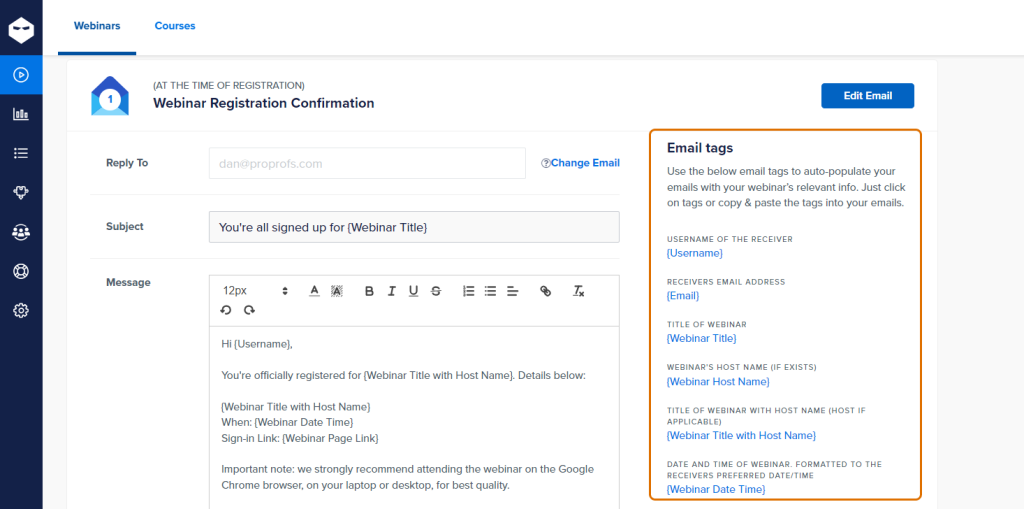
Components:
Thank You Message: Show appreciation for registering.
- Example: “Thank you for registering! We’re thrilled to have you join us.”
Event Details Recap: Reiterate the date, time, and topic of the webinar.
- Example: “Here are the details for the upcoming webinar: [Topic], on [Date] at [Time].”
Access Instructions: Provide the link or details on how to join the webinar.
- Example: “Click this link to join us live: [Webinar Link]”
Add to Calendar: Include calendar links to make it easy to remember.
- Example: “[Add to Google Calendar] [Add to iCal]”
What to Expect: Reconfirm the key takeaways or outcomes of the webinar.
- Example: “Here’s what you’ll gain from attending: [Benefit #1, Benefit #2].”
3. Reminder Email Sequence
These emails are sent before the event to ensure the registrant remembers to attend. Generally, these are sent 24 hours, 1 hour, and sometimes 15 minutes before the event.
Components:
Subject Line: Emphasize the event timing and prompt action.
- Example: “Starts Tomorrow! Don’t Forget to Join [Webinar Topic]”
Friendly Reminder: Acknowledge their interest and remind them of the value.
- Example: “Just a quick reminder – you registered for [Webinar Topic].”
Countdown to Start Time: Mention how soon the webinar is.
- Example: “We’re just 24 hours away from the big event!”
Link to Join: Make the webinar link easily accessible.
- Example: “Click here to join us tomorrow: [Webinar Link]”
What You’ll Miss if You Don’t Attend: A subtle FOMO (fear of missing out) prompt can be effective.
- Example: “Don’t miss out on strategies that could transform your [area of interest].”
4. Live (Last-Minute) Email Sequence
These are often sent just as the webinar is about to start to catch those who may have forgotten or missed earlier reminders.
Components:
Urgency in Subject Line: Signal the immediacy of the event.
- Example: “We’re Live! Join [Webinar Topic] Now!”
Quick Access Link: Provide the link prominently to avoid any last-minute confusion.
- Example: “It’s time! Click here to join us live: [Webinar Link].”
Brief Reminder of Key Benefits: Reinforce why they should join.
- Example: “Don’t miss [Speaker] sharing insights on [Benefit].”
5. Follow-Up Email Sequence
The webinar follow-up email sequence is sent after the webinar to thank attendees, share replay information, and continue engagement with those who registered.
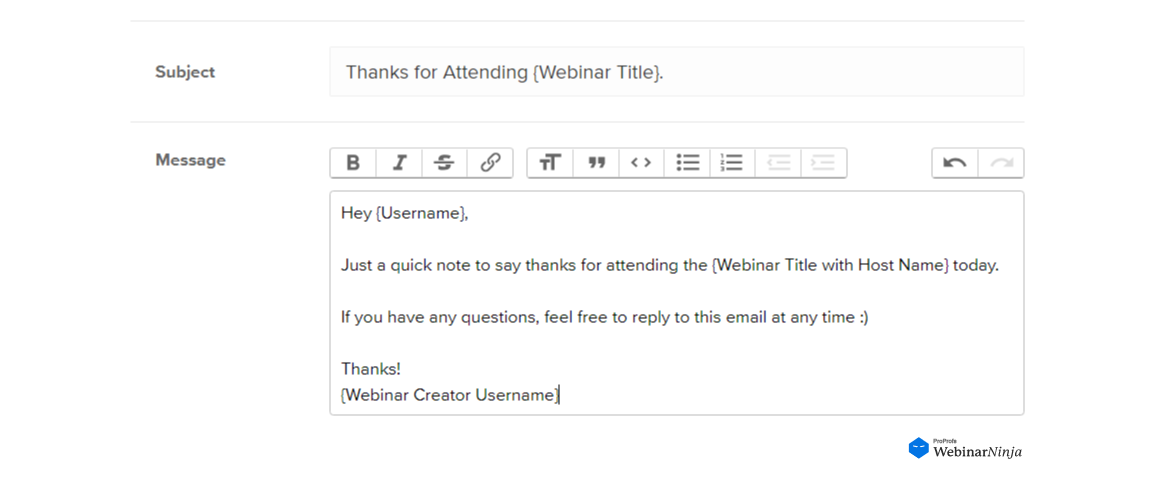
Components:
Thank You Message: Show appreciation to attendees.
- Example: “Thank you for joining us! We hope you enjoyed the session.”
Replay Link: Provide a link to the webinar recording for those who couldn’t attend or want a recap.
- Example: “Missed the live session? Watch the replay here: [Replay Link].”
Next Steps: Offer resources, products, or services for further engagement.
- Example: “Want to dive deeper? Check out our [Related Product/Service/Resource].”
Survey Request (Optional): Gather feedback to improve future webinars.
- Example: “We’d love to hear your thoughts. Please take a quick survey here: [Survey Link].”
6. Nurture or Sales Sequence
This is also a type of post-webinar email sequence that targets attendees or those who watched the replay to convert them into customers.
Components:
Personalized Engagement: Reference insights from the webinar.
- Example: “Since you joined us for [Webinar Topic], we thought you’d find our [Related Offer] helpful.”
Offer Recap: Summarize any offers mentioned during the webinar.
- Example: “Special Offer: For the next 48 hours, get [Offer Details] using code WEBINAR.”
Limited Time CTA: Encourage a quick response if there’s a limited-time offer.
- Example: “Act fast! Offer expires soon. [Buy Now Link]”
Testimonial (Optional): Add social proof if available.
- Example: “Here’s what others are saying about our [Product/Service]: [Customer Testimonial]”
What Are the Types of Webinar Emails?
Some of the major types of webinar emails are as follows:
1. Pre-Webinar Emails
Pre-webinar emails are designed to build excitement, remind registrants of the event, and ensure they’re prepared. These emails can include initial confirmations, reminders, and agenda details.
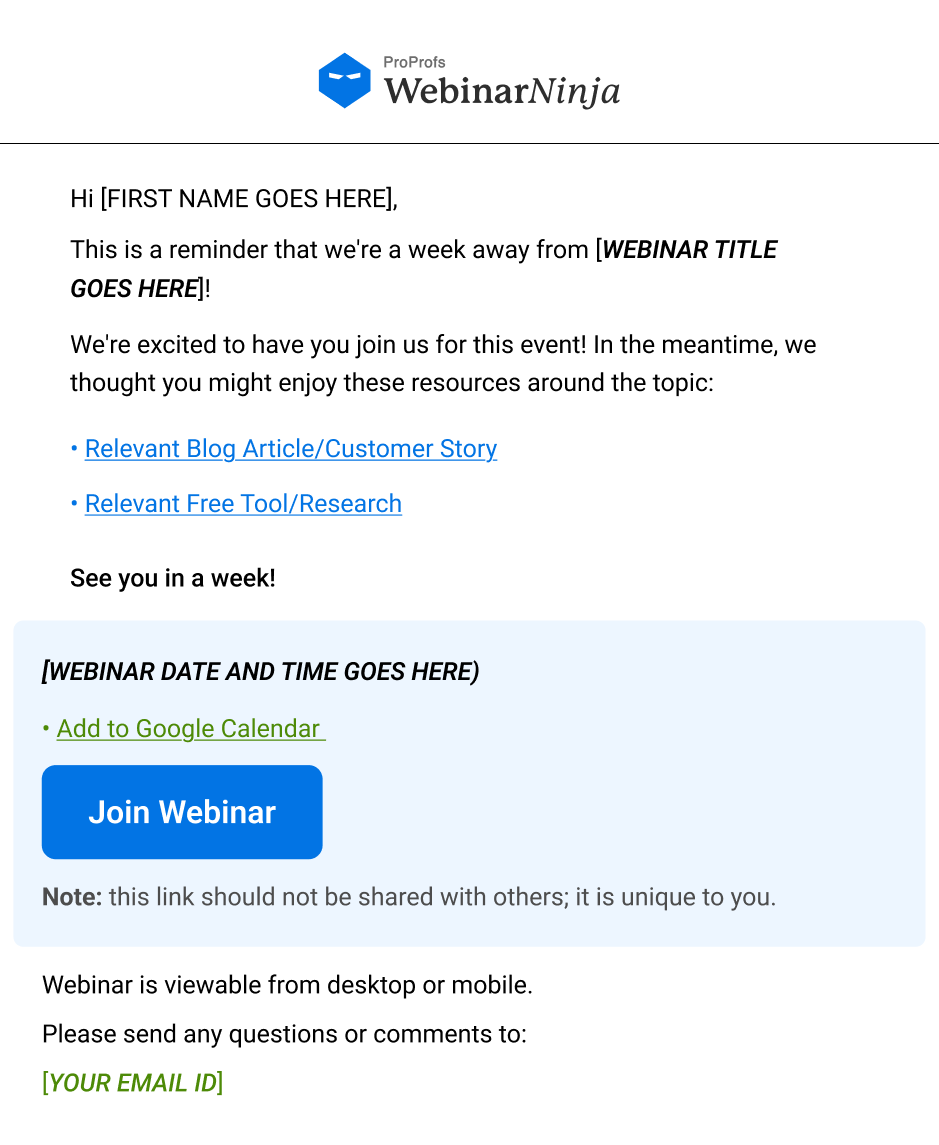
Types and Timing:
- Confirmation Email: Sent immediately after registration to confirm their spot, thank them, and provide event details.
- Reminder Email(s): These can be scheduled a week before, a day before, and an hour before the webinar to ensure attendance. Each reminder should include key information about the session, like the date, time, and topics to be covered.
Best Practices:
- Highlight the benefits of attending.
- Make the joining process simple by including a clear CTA.
- Emphasize the value of the content and any exclusive aspects (e.g., live Q&A, special guest speakers).
- Include an “Add to Calendar” button to help them save the date.
Pre-Webinar Email Sequence Template:
Subject Line: “Get ready for [Webinar Name] 🎉 – Here’s what to expect!”
Body:
Hi [First Name],
Thank you for registering for [Webinar Name]! We’re excited to have you join us on [Date and Time].
Here’s what you can expect:
- [Brief point about the main topic]
- [Detail about a valuable takeaway]
- [Mention any expert speakers or Q&A sessions]
Don’t forget to add the event to your calendar: [Add to Calendar Button]
We’ll send you another reminder before we go live. Can’t wait to see you there!
Best,
The [Your Company Name] Team
2. Live Webinar Day Emails
These emails help drive last-minute engagement, remind participants of the event, and ensure smooth attendance.
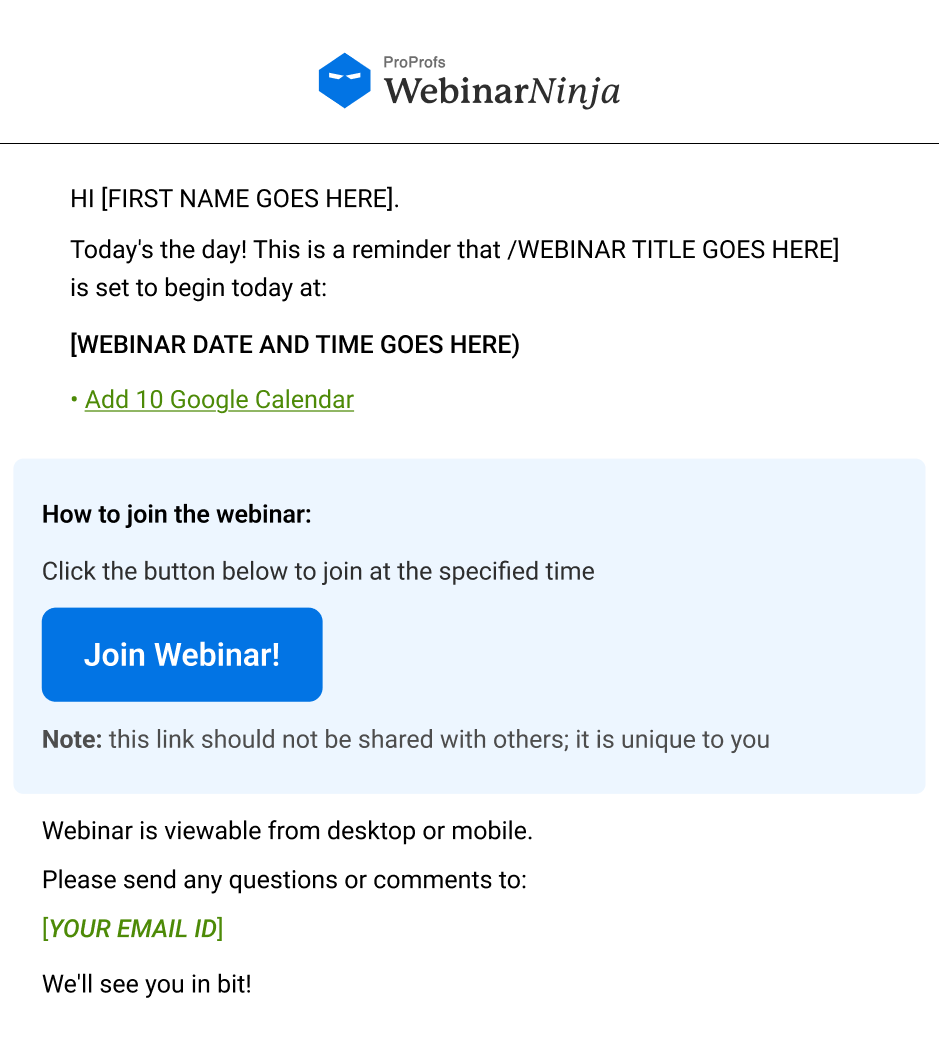
Types and Timing:
- Final Reminder: Sent one hour before the webinar to help registrants remember the start time.
- Join Now Email: Sent right when the webinar starts, including a direct link to the session to make joining quick and seamless.
Best Practices:
- Be concise; the primary focus is on facilitating their attendance.
- Keep the CTA (link to the webinar) highly visible.
- Ensure mobile compatibility, as many people will access this email on their phones.
Live Webinar Email Sequence Template:
Subject Line: “We’re live! Join [Webinar Name] now 🎥”
Body:
Hi [First Name],
It’s time! We’re thrilled to kick off [Webinar Name] right now. Click the link below to join:
[Join Webinar Now Button]
We’ll see you inside for [mention any main topics or notable highlights]. Don’t miss out on the live Q&A!
See you soon!
The [Your Company Name] Team
3. Post-Webinar Follow-Up Emails
Post-webinar email sequences serve to maintain webinar engagement, thank attendees, provide access to on-demand recordings, and nurture leads who didn’t attend.
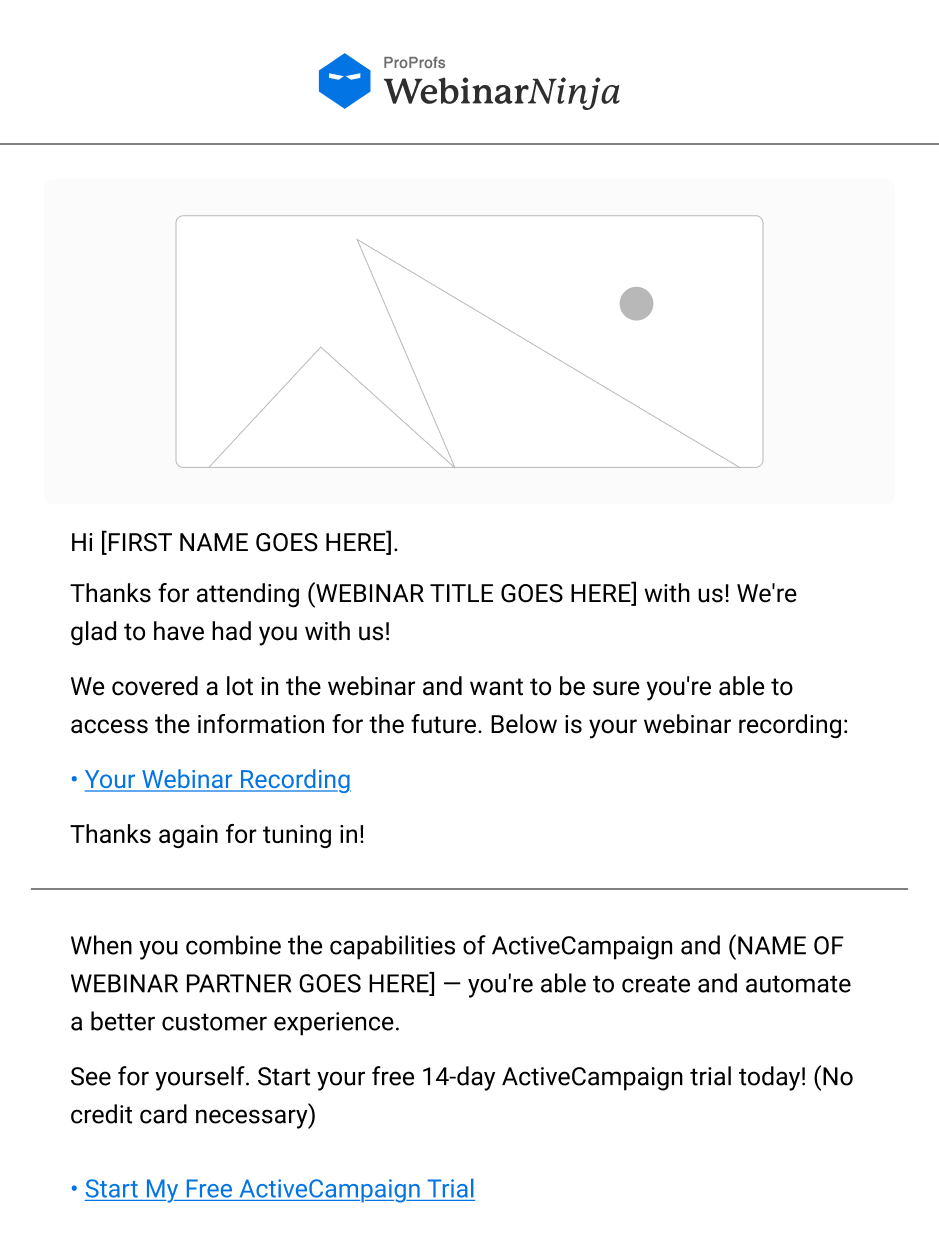
Types and Timing:
- Thank You Email: Sent immediately after the webinar, expressing gratitude for attendance and often including a recording link.
- Non-Attendee Follow-Up: Sent to those who registered but didn’t attend, with an on-demand link to watch the webinar later.
- Content and Resource Follow-Up: A few days later, send additional resources, related content, or special offers based on the webinar topic.
Best Practices:
- Personalize based on attendance (separate emails for attendees and non-attendees).
- Include a clear CTA to encourage watching the recording, visiting a related landing page, or signing up for another webinar.
- Provide valuable resources or follow-up actions to keep participants engaged.
Post-Webinar Email Sequence Template:
For attendees:
Subject Line: “Thanks for joining [Webinar Name]! Here’s the recording 📹”
Body:
Hi [First Name],
Thank you for attending [Webinar Name]! We hope you found the session valuable and gained insights on [mention main topics covered].
Watch the Recording Anytime:
[Access Recording Button]
Related Resources:
- [Resource 1: Guide or eBook]
- [Resource 2: Blog Post or Article]
- [Link to upcoming related event]
We look forward to seeing you at future events!
Best Regards,
The [Your Company Name] Team
For non-attendees:
Subject Line: “Missed [Webinar Name]? Here’s the recording to catch up 🎬”
Body:
Hi [First Name],
We’re sorry we missed you at [Webinar Name]! But we’ve got you covered – here’s the recording so you can catch up on everything we covered:
[Watch the Webinar Recording]
Plus, we’re sharing some additional resources to dive even deeper:
- [Link to Resource 1]
- [Link to Resource 2]
Looking forward to seeing you next time!
Best,
The [Your Company Name] Team
Best Practices for Webinar Email Sequences
Here are some tips and tricks to ensure great outcomes with your webinar email sequences:
1. Tease the Outcome, Not the Agenda
Focus on the transformation or result your attendees will experience by attending the webinar, not just the topics. Emphasize the big-picture benefits to create excitement and curiosity.
2. Hit Peak Curiosity with “Secret” and “Exclusive” Hooks
Use intriguing language that implies unique insights they won’t find anywhere else. Words like “Exclusive Insider Tips” or “Little-Known Secrets” can make the value feel exclusive and time-sensitive.
3. Showcase Social Proof Early
In early emails, include testimonials, case studies, past attendee feedback, or endorsements from well-known figures to build trust. Highlight the value of the speaker’s expertise to make the webinar irresistible.
4. Countdown to Urgency with Last-Minute Reminder
Send a reminder email 1–2 hours before the webinar that builds urgency and gives final access info. Include a one-click “join” link and emphasize that it’s their last chance to attend live for real-time benefits.
5. Incorporate a “Sneak Peek” Replay Offer in Follow-Up
After the webinar, offer a limited-time replay that expires soon, even if you plan to keep it available. This limited availability triggers scarcity and helps convert those who missed it.
6. Use Micro-Commitments in Registration Confirmation Email
Invite them to take a tiny step right away, like responding with a quick question, sharing their top goals, or even just connecting on LinkedIn. This initial interaction primes them for higher engagement during the webinar.
7. Personalize Follow-Ups Based on Attendance
Send tailored webinar emails based on whether they attended or missed the session. For those who attended, offer additional resources or a recap. For those who missed, emphasize what they missed and the limited time to catch up.
8. Add a Social Share Option for Free Perks
Offer an extra worksheet, checklist, or valuable download if attendees share the webinar with a friend. This not only adds value but can also expand your reach without additional marketing effort.
9. Create a Sense of Community in Pre-Webinar Emails
Send a “who’s attending” email with names, industries, or locations (if possible) to give a sense of community and engagement before the event. Attendees are more likely to attend live if they feel they’re joining a group of like-minded people.
10. Optimize Send Times with Data
Use past webinar attendance and engagement data to find the optimal send times for reminders and confirmations, ensuring your emails hit inboxes when they’re most likely to be opened and acted upon.
What Are the Benefits of a Webinar Email Sequence?
Here are some of the major benefits of using an effective email sequence for webinars:
1. Boosts Registration Rates
A well-planned email sequence can help increase registrations by creating anticipation and encouraging sign-ups. Early reminder emails with compelling subject lines, personalized content, and value-driven messaging can attract more people to register.
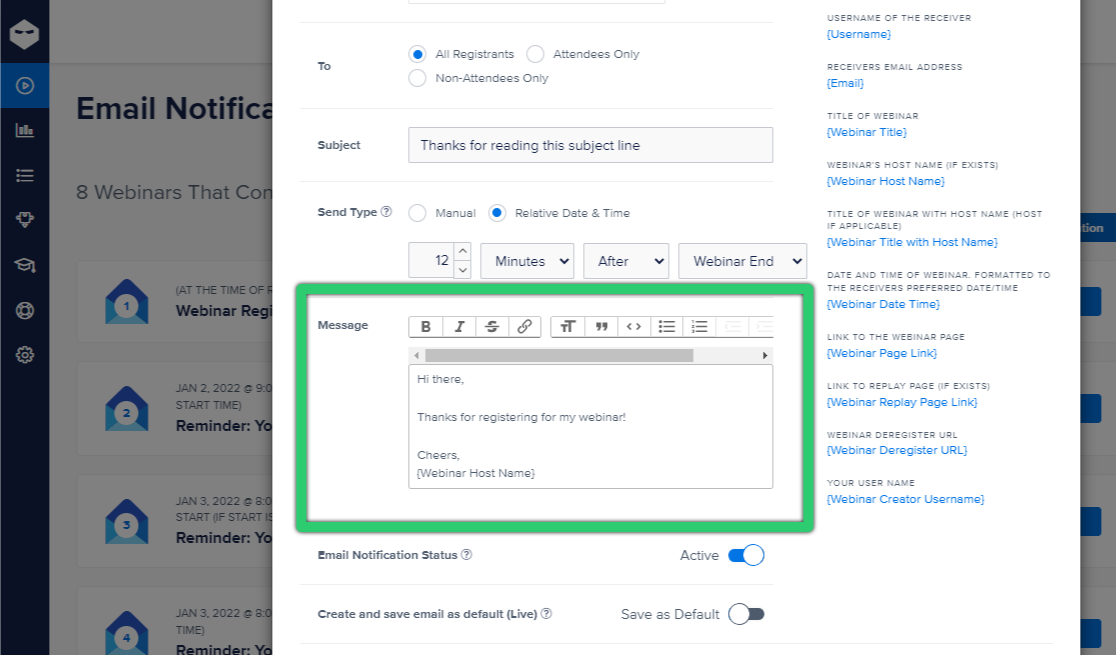
2. Increases Show-Up Rates
Even after people register, there’s a risk of them forgetting or missing the event. Reminder emails, including a countdown to the webinar and last-minute reminders, help keep it top of mind, significantly improving the likelihood that registrants will attend.
3. Prepares the Audience for Better Engagement
A “prep email” can outline what to expect, provide related resources, or even include an agenda. This primes attendees to be more engaged and ready to interact, making the webinar more effective and enjoyable.
4. Enhances Post-Webinar Follow-Up
Post-webinar emails can include thank-you messages, summaries, and follow-up content like recordings or further resources. These emails keep the conversation going, generate leads, and convert attendees into customers by reinforcing key messages and offering relevant next steps.
5. Segmentation and Personalization
Email sequences allow for targeted messaging based on registration and attendance behavior. For example, you can send different follow-ups to those who attended versus those who missed it, tailoring the content to each group for maximum relevance.
6. Improves Conversion Rates
Well-timed follow-ups can encourage attendees to act, such as signing up for a product demo, downloading a resource, or purchasing. A strategic email sequence maximizes the potential for turning attendees into paying customers.
7. Saves Time with Automation
Automated email sequences can be set up to run on autopilot, saving time and resources. Once created, the sequence can run for future webinars with only minor tweaks, making it a highly efficient marketing strategy.
8. Gathers Insights and Feedback
You can include surveys or feedback forms in post-webinar emails to collect insights that can improve future webinars. Additionally, analyzing the email sequence’s open rates, click-through rates, and engagement levels can reveal what resonates most with your audience.
9. Strengthens Brand Authority and Trust
A well-executed sequence provides consistent value, reinforcing the brand’s expertise and reliability. Even if recipients don’t attend the webinar, they may remember the brand for future needs.
Webinar Email Sequences: Common Mistakes to Avoid
When planning a webinar, email sequences are crucial for driving attendance, engaging participants, and maximizing the value of your event.
However, many businesses fall into common traps that can reduce the effectiveness of these emails. Here are some of the common mistakes to avoid in webinar email sequences:
1. Sending Generic Emails
Mistake: Using the same email copy for every recipient without personalization.
Solution: Segment your list based on audience interests or engagement levels, and personalize emails with names and relevant content. Tailor messages to address specific pain points or interests of your target audience.
2. Inconsistent Frequency
Mistake: Sending too many emails or too few. Over-emailing can lead to unsubscribes, while too few emails may result in lower attendance.
Solution: Develop a well-paced email sequence, typically including a confirmation email, reminders leading up to the event, a “last chance” email, and post-webinar follow-ups. Make sure emails are spread out to maintain engagement without overwhelming recipients.
3. Neglecting Reminder Emails
Mistake: Sending only one or two emails and expecting registrants to remember the event.
Solution: Include at least three reminder emails—one week before, one day before, and one hour before the webinar. This helps keep the event top-of-mind and increases attendance rates.
4. Skipping the “Value Proposition” in Subject Lines
Mistake: Writing vague or unexciting subject lines that don’t highlight the value of attending the webinar.
Solution: Create compelling, benefit-driven subject lines that encourage opening. Instead of “Webinar Registration,” try “Discover 5 Strategies to Boost Your Sales—Join Our Webinar!”
5. Weak Calls to Action (CTAs)
Mistake: Using generic CTAs like “Register Now” without clear urgency or benefit.
Solution: Use specific, action-oriented CTAs like “Reserve Your Spot” or “Save My Seat for Expert Insights.” Add urgency with phrases like “Limited Spots Available” or “Final Registration.”
6. Failing to Address “What’s in it for Me?”
Mistake: Focusing on the webinar details without explaining the tangible benefits for attendees.
Solution: Highlight what the audience will gain from attending, such as actionable insights, exclusive content, or expert advice. Make it clear why the webinar is worth their time.
7. Not Optimizing for Mobile
Mistake: Designing emails that aren’t mobile-friendly leads to readability issues for mobile users.
Solution: Ensure your email design is responsive. Use concise copy, large buttons, and a clean layout to improve the mobile experience.
8. Overlooking Post-Webinar Follow-Up
Mistake: Not following up with attendees and registrants who missed the webinar.
Solution: Send a thank-you email to attendees with a recap, recording, and any promised resources. For those who missed the event, provide a link to the recording or offer a chance to join the next session.
9. Ignoring Analytics
Mistake: Sending email sequences without tracking open rates, click-through rates, or conversions.
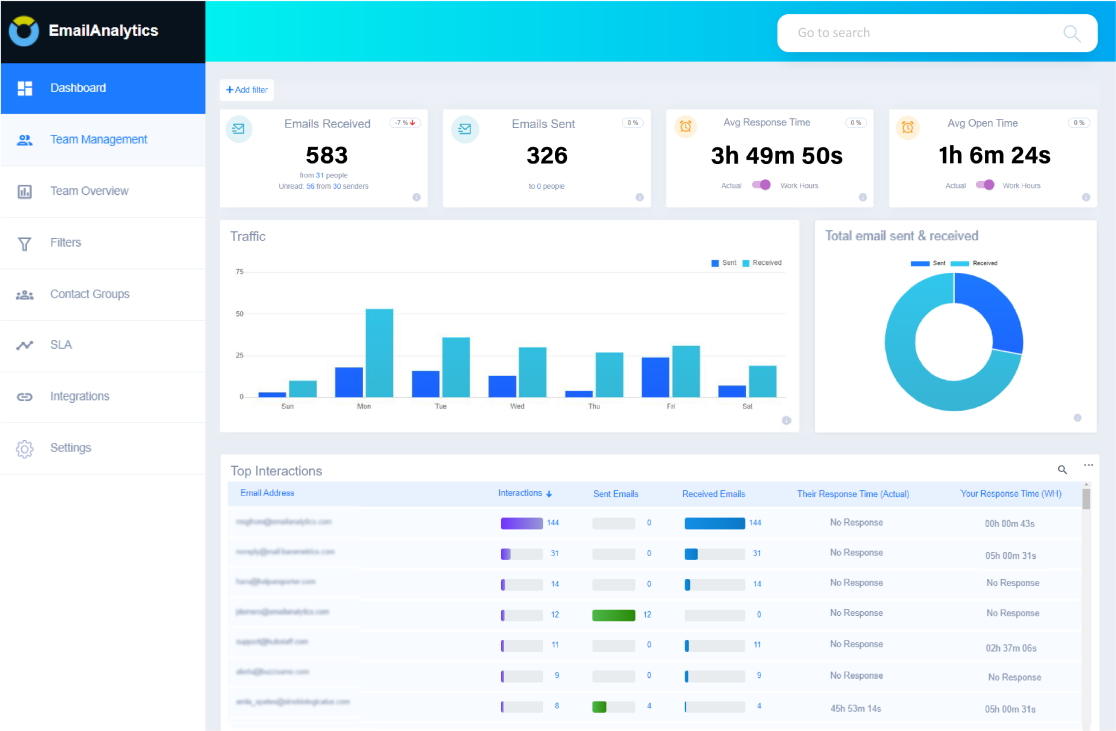
Solution: Analyze performance data to understand which emails performed best and where registrants dropped off. Use these insights to improve future webinar email sequences.
10. Underestimating the Importance of Timing
Mistake: Sending emails at inconvenient times, like weekends or late at night.
Solution: Schedule emails to land in inboxes at times when your audience is most likely to read them, typically mid-morning or mid-afternoon on weekdays.
Drive Better Conversions With Targeted Email Sequences
A well-planned email sequence is the backbone of webinar engagement, guiding potential attendees from awareness to attendance and beyond. You need to create targeted emails that help capture attention, build anticipation, and keep audiences engaged, ultimately boosting both attendance rates and conversions.
By segmenting emails to meet the needs of each audience type—whether new leads, active registrants, or previous attendees—you can maximize the impact of each message sent.
For the best results, choose a robust webinar platform like WebinarNinja. It enhances engagement by allowing you to create and schedule tailored email sequences, automate follow-ups, and personalize reminders, making it easy to build connections and drive conversions.
Want to host a webinar for free?
Use WebinarNinja to teach, improve marketing, and grow your sales.


